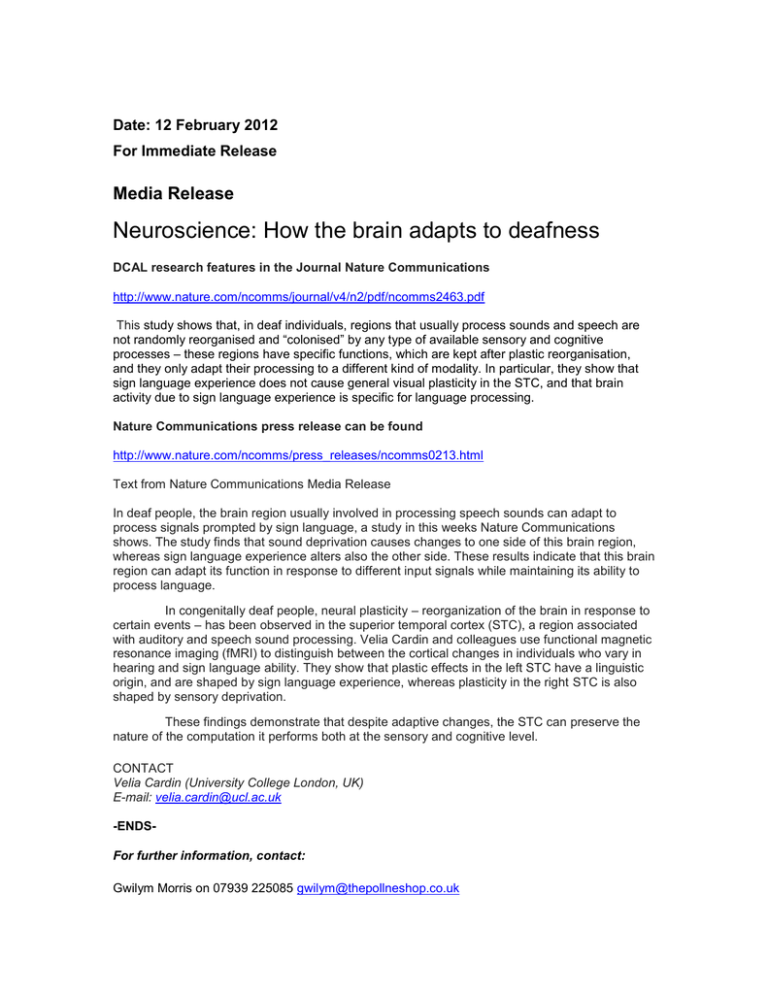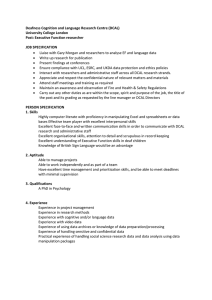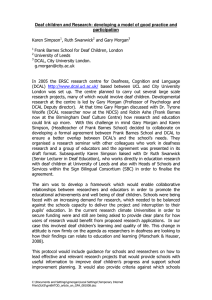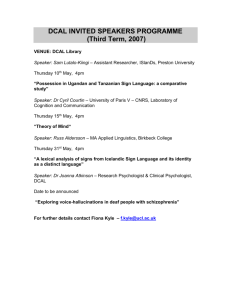Neuroscience: How the brain adapts to deafness Media Release
advertisement

Date: 12 February 2012 For Immediate Release Media Release Neuroscience: How the brain adapts to deafness DCAL research features in the Journal Nature Communications http://www.nature.com/ncomms/journal/v4/n2/pdf/ncomms2463.pdf This study shows that, in deaf individuals, regions that usually process sounds and speech are not randomly reorganised and “colonised” by any type of available sensory and cognitive processes – these regions have specific functions, which are kept after plastic reorganisation, and they only adapt their processing to a different kind of modality. In particular, they show that sign language experience does not cause general visual plasticity in the STC, and that brain activity due to sign language experience is specific for language processing. Nature Communications press release can be found http://www.nature.com/ncomms/press_releases/ncomms0213.html Text from Nature Communications Media Release In deaf people, the brain region usually involved in processing speech sounds can adapt to process signals prompted by sign language, a study in this weeks Nature Communications shows. The study finds that sound deprivation causes changes to one side of this brain region, whereas sign language experience alters also the other side. These results indicate that this brain region can adapt its function in response to different input signals while maintaining its ability to process language. In congenitally deaf people, neural plasticity – reorganization of the brain in response to certain events – has been observed in the superior temporal cortex (STC), a region associated with auditory and speech sound processing. Velia Cardin and colleagues use functional magnetic resonance imaging (fMRI) to distinguish between the cortical changes in individuals who vary in hearing and sign language ability. They show that plastic effects in the left STC have a linguistic origin, and are shaped by sign language experience, whereas plasticity in the right STC is also shaped by sensory deprivation. These findings demonstrate that despite adaptive changes, the STC can preserve the nature of the computation it performs both at the sensory and cognitive level. CONTACT Velia Cardin (University College London, UK) E-mail: velia.cardin@ucl.ac.uk -ENDSFor further information, contact: Gwilym Morris on 07939 225085 gwilym@thepollneshop.co.uk Notes to editors 1. Authors and their affiliations a. Cognitive, Perceptual and Brain Sciences Department, Deafness, Cognition and Language Research Centre, 49 Gordon Square, University College London, London WC1H 0PD, UK. i. Velia Cardin, ii. Eleni Orfanidou & iii. Bencie Woll b. Linnaeus Centre HEAD, Swedish Institute for Disability Research, Department of Behavioural Sciences and Learning, Linköping University, Linköping 581 83, Sweden. i. Velia Cardin, ii. Jerker Rönnberg & iii. Mary Rudner c. Department of Psychology, University of Crete, 581 83 Crete, 74100, Greece. i. Eleni Orfanidou d. Centre of Clinical and Cognitive Neuroscience, School of Psychological Sciences, University of Manchester, Manchester M13 9PL, UK. i. Cheryl M. Capek 2. Deafness Cognition and Language (DCAL) Research Centre is based at University College London. DCAL is a world-renowned centre of excellence for research on BSL. The centre brings together leading Deaf and hearing researchers in the fields of sign linguistics, psychology, and neuroscience. DCAL is funded by The Economic Social Research Council (ESRC). http://www.dcal.ucl.ac.uk 3. The Economic and Social Research Council (ESRC) is the UK's largest organisation for funding research on economic and social issues. It supports independent, high quality research which has an impact on business, the public sector and the third sector. The ESRC’s total budget for 2012/13 is £205 million. At any one time the ESRC supports over 4,000 researchers and postgraduate students in academic institutions and independent research institutes. More at www.esrc.ac.uk


![[PowerPoint 2007] presentation file](http://s2.studylib.net/store/data/005406460_1-7834316c409f9802f7aec3d8538324fb-300x300.png)
